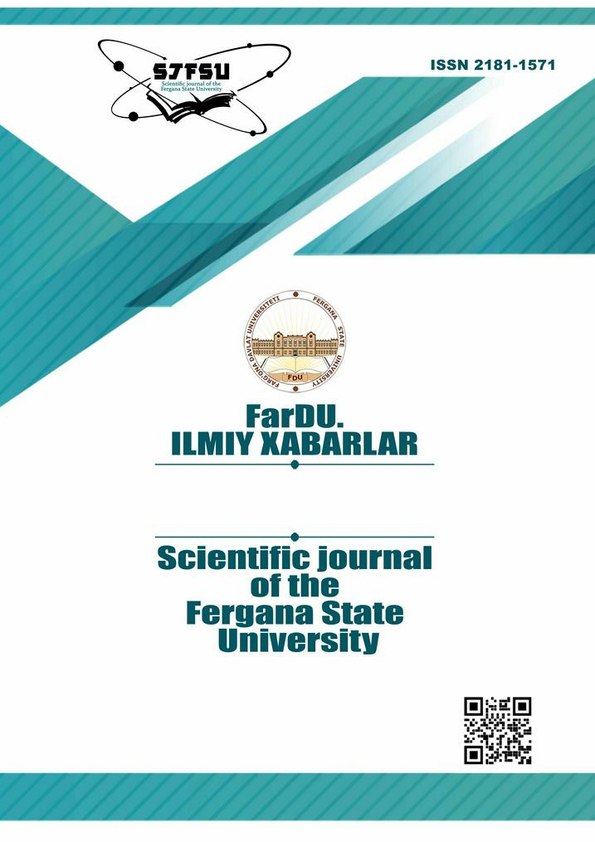GENINING POLIMORFIZMI ATOPIK DERMATITDA
##plugins.themes.bootstrap3.article.main##
Annotatsiya
Adabiyotlarga ko‘ra, atopik dermatit (AtD) bilan og‘rigan bolalarning 80% oilaviy anamnezga ega. Shu bilan birga, atopik kasalliklar bilan bog‘liqlik ko‘pincha ona tomonida (60-70%), kamroq ota tomonida (18-22%) aniqlanadi. Ikkala ota-onada ham atopik kasalliklarning mavjudligi bolada AtD rivojlanish xavfini 60-80% gacha oshiradi [2]. Atopiya ota-onalarning birida bilan u 45-50% gacha kamayadi [1, 2]. Kasallikning 50% tarqalish xavfi autosom-dominant tipda nasllanishidir. Ammo shu bilan birga, u vulgar ixtiozdan farqli o‘laroq, hech qachon bunday hisoblanmagan.
##plugins.themes.bootstrap3.article.details##
Tsya robota litsenzuetsya vydpovídno do Creative Commons Attribution-NonCommercial-NoDerivatives 4.0 xalqaro litsenziyasi.
Foydalaniladigan adabiyotlar
Атопический дерматит: новые подходы к профилактике и наружной терапии. Рекомендации для врачей /Под ред. Ю. В. Сергеева М.: Медицина для всех,2005.с.64.
Хёгер Петер Г.Детская дерматология /Пер. с нем. под ред. А. А. Кубановой, А.Н.Львова. — М.: Издательство Панфилова; БИНОМ. Лаборатория знаний, 2013.с.648.
Sandilands A, Terron-Kwiatkowski A, Hull PR et al. Comprehensive analysis of the gene encoding filaggrin uncovers prevalent and rare mutations in ichthyosis vulgaris and atopic eczema. //Nat Genet. 2007 May;39(5):650-4.
Nishanbayeva N.Yu., Mirraximova M.X. Bolalarda atopik dermatitda oshqozon ichak traktidagi klinik laborator o‘zgarishlarni aniqlash, tashxislash va davolash tamoyillarini takomillashtirish //«Tibbiyotda yangi kun» 6(38/1)2021 ISSN 2181-712X. EISSN 2181-2187 pp.720-726.
Смит К., Калко С., Кантор Ч. Пульс-электрофорез и методы работы с большими молекулами ДНК. //Анализ генома. Под ред. К.Дейвиса, пер. с англ.М:Мир.1990.С.58-94.
Wong Y. K., Chang K.W., Cheng C. Y., Liu C. J. Association of CTLA-4 gene polymorphism with oral squamous cell carcinoma. //J. Oral Pathol. Med. 2006 35:51-4
Jones G, Wu S, Jang N, Fulcher D, Hogan P, Stewart G. Polymorphisms within the CTLA4 gene are associated with infant atopic dermatitis. Br J Dermatol. 2006 Mar; 154(3):467-71.
Magistrelli G., Jeannin P., Herbault N., Benoit de Coignac A., et al. A soluble form of CTLA-4 generated by alternative splicing is expressed by nonstimulated human T cells.//Europ.J. Immun.1999. Vol.29.p.3596-3602.
Harper K., Balzano C., Rouvier E., Mattei M.-G., et al. CTLA-4 and CD28 activated lymphocyte molecules are closely related in both mouse and human as to sequence, message expression, gene structure, and chromosomal location. // J. Immun.1991.Vol. 147.p.1037-1044.
Mirrakhimova M.H., Nishanbaeva N.Y., Clinical Manifestations Of Connective Tissue Dysplasia In Children With Glomerulonephritis //Journal of Pharmaceutical Negative Results/Volume 13/Special Issue 9 ¦ 2022,rr.4203-4205.
Oaks M. K., Hallett K. M. Cutting edge: a soluble form of CTLA-4 in patients with autoimmune thyroid disease. // J.Immun. 2000. Vol. 164. р. 5015-5018
Kouki T., Sawai Y., Gardine C. A., Fisfalen M.-E., et al. CTLA-4 gene polymorphism at position 49 in exon 1 reduces the inhibitory function of CTLA-4 and contributes to the pathogenesis of Graves’ disease. // J. Immun. 2000. Vol.165. p.6606—6611.
Nistico L., Buzzetti R., Pritchard L. E., Van der Auwera B., et al. The CTLA-4 gene region of chromosome 2q33 is linked to, and associated with, type 1 diabetes.//Hum.Molec.Genet.1996. Vol. 5.р.1075-1080.
Lee YH, Choi SJ, Ji JD, Song GG. The CTLA-4 +49 A/G and −318 C/T polymorphisms and susceptibility to asthma: a meta-analysis. Mol Biol Rep. 2012 Aug;39(8):8525-32.doi:10.1007/s11033-012-1707-8.
Choi WA, Kang MJ, Kim YJ, Seo JH, Kim HY, Kwon JW, Yu J, Park SJ, Lee YC, Hong SJ. Gene-gene interactions between candidate gene polymorphisms are associated with total IgE levels in Korean children with asthma. J Asthma. 2012 Apr;49(3):243-52.
Sonkoly E, Janson P, Majuri ML, Savinko T, Fyhrquist N, Eidsmo L, Xu N, Meisgen F, Wei T, Bradley M, Stenvang J, Kauppinen S, Alenius H, Lauerma A, Homey B, Winqvist O, Ståhle M, Pivarcsi A. MiR-155 is overexpressed in patients with atopic dermatitis and modulates T-cell proliferative responses by targeting cytotoxic T lymphocyte-associated antigen 4. J Allergy Clin Immunol. 2010 Sep;126(3):581-9.
Stene LC, Rønningen KS, Bjørnvold M, Undlien DE, Joner G. An inverse association between history of childhood eczema and subsequent risk of type 1 diabetes that is not likely to be explained by HLA-DQ, PTPN22, or CTLA4 polymorphisms. Pediatr Diabetes. 2010 Sep;11(6):386-93.
Oh KY, Kang MJ, Choi WA, Kwon JW, Kim BJ, Yu J, Hong SJ. Association Between Serum IgE Levels and the CTLA4 +49A/G and FCER1B −654C/T Polymorphisms in Korean Children With Asthma. Allergy Asthma Immunol Res. 2010Apr;2(2):127-33.
Choi SY, Sohn MH, Kwon BC, Kim KE. CTLA-4 expression in T cells of patients with atopic dermatitis. Pediatr Allergy Immunol. 2005 Aug;16(5):422-7. Erratum in:Pediatr Allergy Immunol. 2005 Sep;16(6):554.
Yang KD, Liu CA, Chang JC, Chuang H, Ou CY, Hsu TY, Wang CL. Polymorphism of the immune-braking gene CTLA-4 (+49) involved in gender discrepancy of serum total IgE levels and allergic diseases. Clin Exp Allergy. 2004 Jan;34(1):32 4.
Mirrakhimova M.K. Improving methods of treatment of atopic pathology in children //Journal of Critical Reviews.-№12.-р. 190-192
Yakhyaeva K.Z., Iskanova G.X., Olimova R.R. The role of lipid metabolism marks and atherogenicity index in children with GLOMERULONEFRITIS. //International scientific and practical Conference. Modern views and research – 2022





